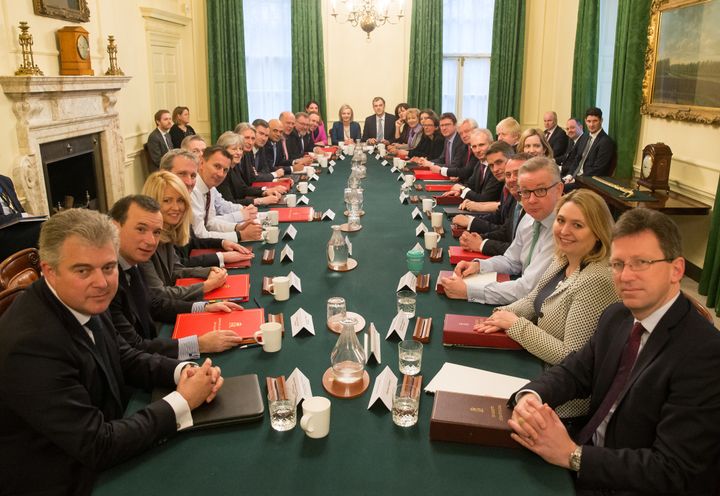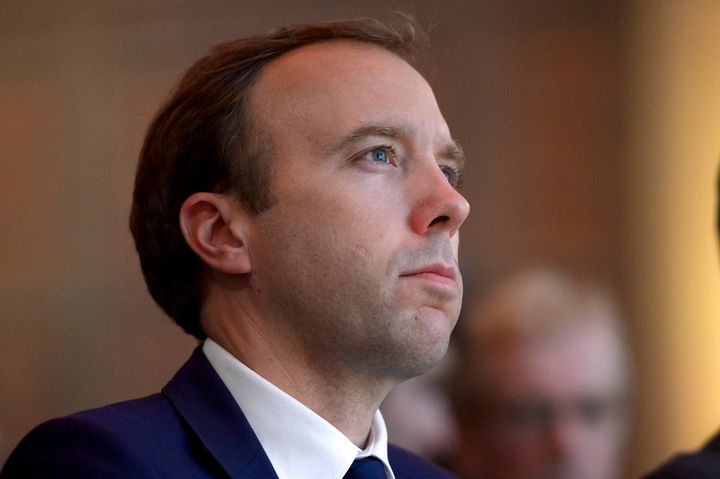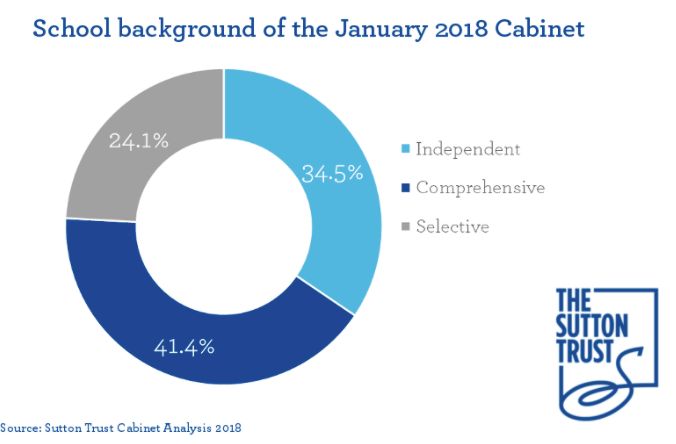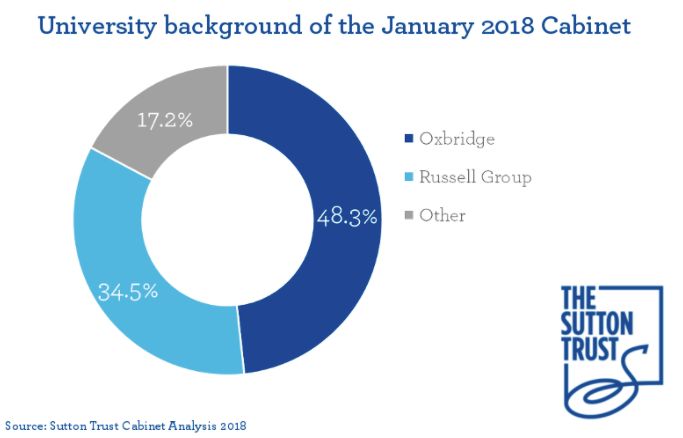
Theresa May’s new Cabinet has five times more privately-educated people than in the general population, analysis has revealed.
Of the 23 ministers who make up the Government’s top team, 34% attended fee-paying schools - up from 30% in May’s first Cabinet in July 2016, social mobility charity The Sutton Trust has discovered.
According to the Independent Schools Council, just 6.5% of pupils in the UK are educated privately.
As well as an over-representation of private school alumni, almost half – 48% - of Cabinet ministers went to either Oxford or Cambridge universities.
Despite May claiming the reshuffle ensures the Government “looks more like the country it serves”, just six of the 23 Cabinet Ministers are women, and only one comes from a non-white ethnic group.
Of the six additional ministers attending Cabinet, four are women and all are white.
Dr Lee Elliot Major, Chief Executive of the Sutton Trust: “Theresa May made great progress in the composition of her first cabinet, so it is disappointing that yesterday’s reshuffle means that progress has reversed a little.
“The Prime Minister’s Cabinet has to reflect the society that they represent and this is a step in the wrong direction.
“Anyone should be able to become a minister, regardless of social background.
“Today’s figures remind us how important it is to make sure that young people from low and middle income backgrounds also have access to the best schools and the best universities that will enable them to get to the top of so many of our professions which remain largely the preserve of the privately educated.”

No10 yesterday claimed that one aim of the reshuffle was to “reflect the country it serves”.
Asked by HuffPost whether educational background was taken into account as part of the reshuffle decisions, the PM’s official spokesman replied: “What is important is producing a government that can deliver on the priorities of the British and deliver social mobility.
“There are many factors taken into account in reshuffles, but overall the Government is here to serve the British public.”
The spokesman also stressed that compared to David Cameron’s Cabinets, the figures were better.
“You can look at the statistics from the Sutton Trust and I think what it says is the percentage of the Cabinet educated at comprehensive of state selective schools is still significantly higher than it was in 2015.
“I think more broadly what I’d point you to is the Government’s commitment to deliver on social mobility. Some 1.9m more children in good or outstanding schools than in 2010, disadvantaged young people entering university at record rates and the employment rate at a near record high.
“It’s still performing significantly better than in 2015. Social mobility is a priority of the Prime Minister.”
Of the newly-appointed Cabinet Minsters, Culture Secretary Matthew Hancock and Work and Pensions Secretary Esther McVey were privately-educated, as was Immigration Minister Caroline Noakes, who also attends Cabinet.
Former Education Secretary Justine Greening, former Conservative Party chairman Patrick McLoughlin and former Northern Ireland Secretary James Brokenshire were all state-educated.
Others who received private education include Foreign Secretary Boris Johnson (Eton), Home Secretary Amber Rudd (Cheltenham Ladies College) and Health Secretary Jeremy Hunt (Charterhouse).
May attended a fee-paying school from the age of 11 to 13, before moving to a grammar school.

Commenting on the reshuffle, May said: “This Government is about building a country fit for the future – one that truly works for everyone with a stronger economy and a fairer society.
“This reshuffle helps us do just that by bringing fresh talent into Government, boosting delivery in key policy areas like housing, health and social care, and ensuring the Government looks more like the country it serves.
“It also allows a new generation of gifted Ministers to step up and make life better for people across the whole UK.”
In a bid to a highlight the promotion of women to lower ranks in the Government, May tweeted out a photo of herself with her new team of junior whips: Kelly Tolhurst, Mims Davies, Amanda Milling, Jo Churchill, Wendy Morton, and Nusrat Ghani MP.
Yet despite these appointments, the top four positions in the whips office are all held be men: Chief Whip Julian Smith MP, Deputy Chief Whip Christopher Pincher MP, and Government Whips Chris Heaton-Harris MP and Mark Spencer.
But No.10 also faced questions from newspapers like the Daily Mail and Daily Telegraph as to the racial make-up of the new Government.
Asked by the Mail if the reshuffle amounted to “positive discrimination” for minority ethnic MPs, the PM’s spokesman said: “It’s important the government reflects the country it serves. It is a case of getting talent in place.”
When the Telegraph asked if May was sending a signal that ‘white men can’t do the job’, the spokesman replied: “If you look across the Government it’s very clear there is going to be a contribution from MPs of all intakes and of all types.” It was a move to “bring fresh talent through to government and to give that talent an opportunity to shine”.

While May’s Cabinet is made up of fewer private-educated ministers than previous Tory governments, it is still way ahead of Labour PM Clement Attlee, who had just 25% of his 1945 Cabinet from fee-paying schools.
Share of Cabinets who were privately-educated
David Cameron (2015) – 50%
David Cameron/Nick Clegg (2010) – 62%
Gordon Brown (2007) – 32%
Tony Blair (1997) – 32%
John Major (1992) – 71%
Margaret Thatcher (1979) – 91%
Clement Attlee (1945) – 25%